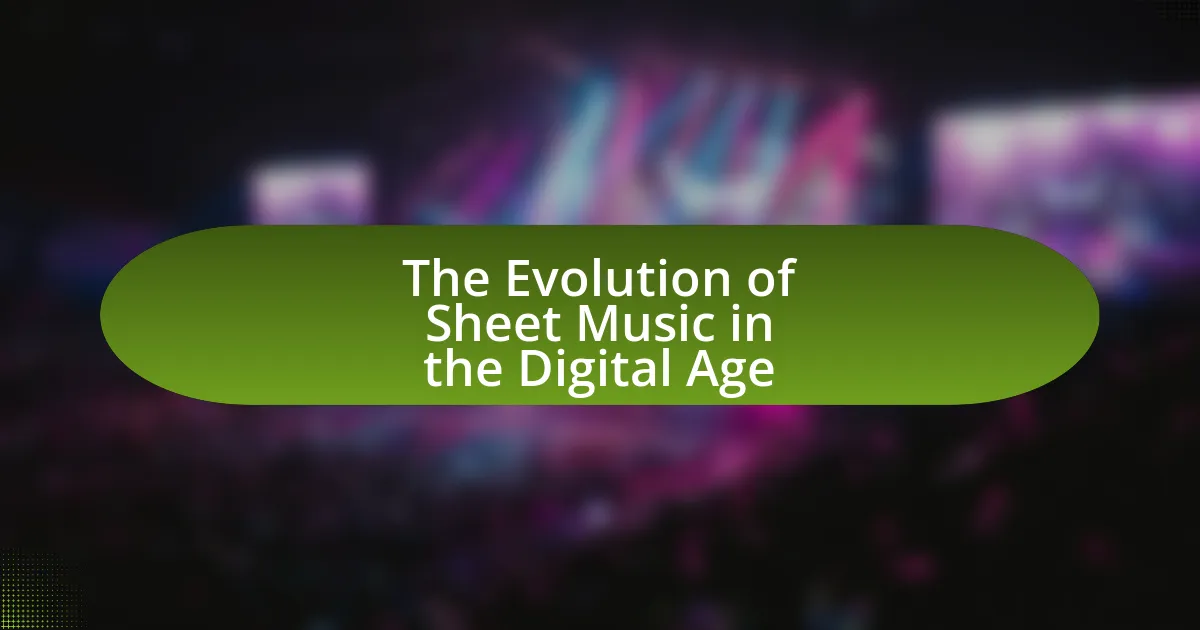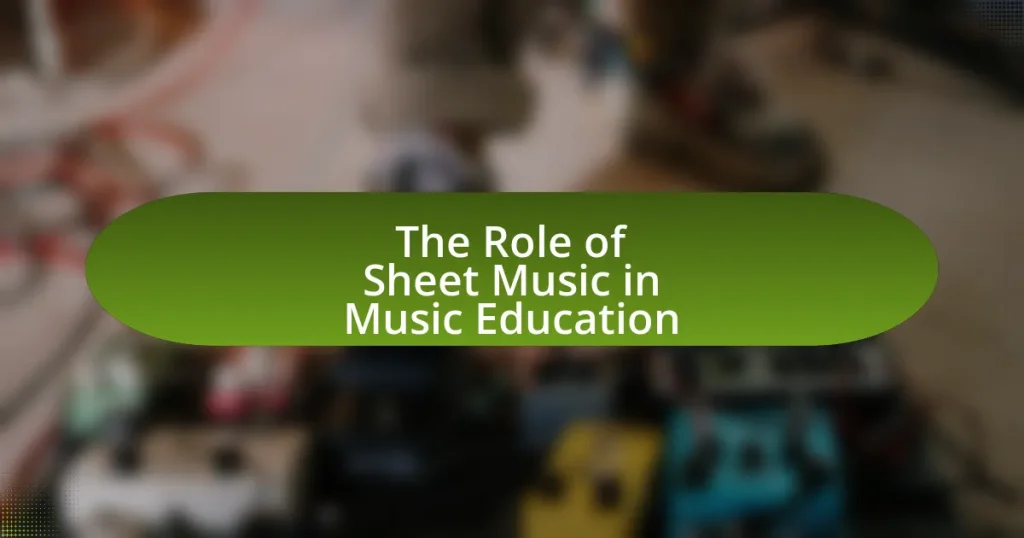The article examines the evolution of sheet music in the digital age, highlighting the transition from traditional printed formats to digital platforms. It discusses how advancements in technology, such as music notation software and online distribution services, have transformed the creation, sharing, and consumption of sheet music. Key topics include the impact of digital tools on composition processes, changes in distribution methods, and the implications for music education. Additionally, the article addresses challenges faced by composers in the digital market, including copyright issues and market saturation, while exploring future trends and innovations in digital sheet music.
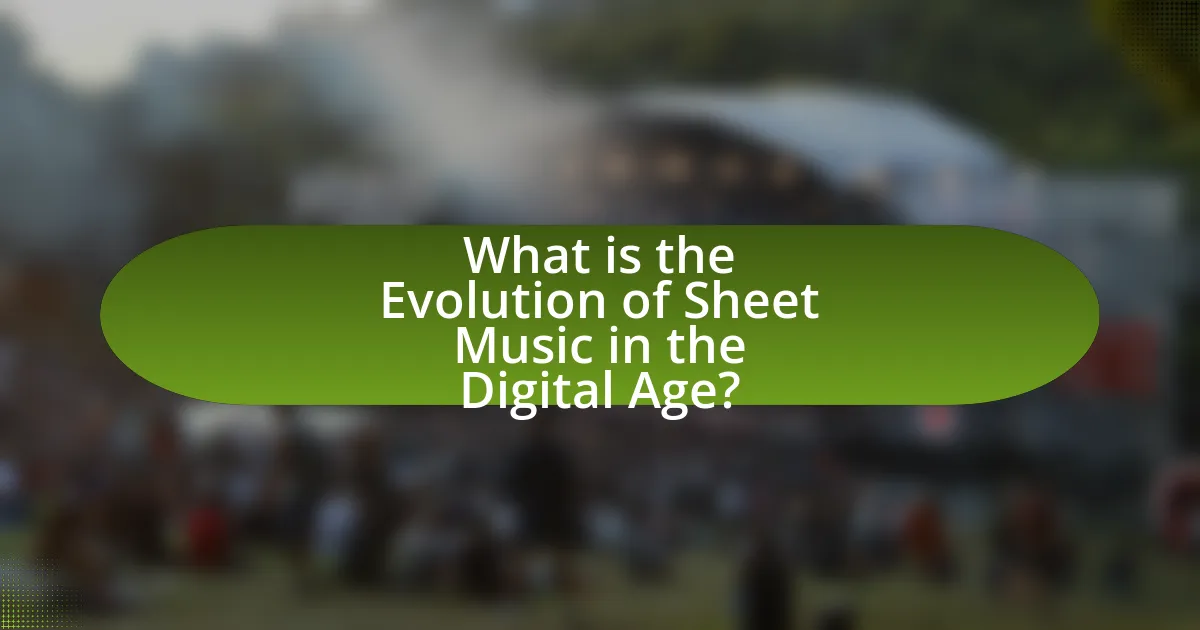
What is the Evolution of Sheet Music in the Digital Age?
The evolution of sheet music in the digital age has transformed how music is created, distributed, and consumed. Traditional printed sheet music has largely transitioned to digital formats, allowing for easier access and sharing through platforms like Musicnotes and MuseScore. This shift has been facilitated by advancements in technology, such as the development of music notation software like Sibelius and Finale, which enable composers to create and edit scores digitally. Additionally, the rise of mobile applications has made it possible for musicians to access vast libraries of sheet music on devices, enhancing convenience and portability. According to a report by the International Federation of the Phonographic Industry, digital music consumption has increased significantly, reflecting a broader trend towards digital formats in the music industry.
How has technology influenced the creation of sheet music?
Technology has significantly influenced the creation of sheet music by enabling digital notation software, which streamlines the composition and arrangement process. Programs like Sibelius and Finale allow composers to input music using MIDI instruments or computer keyboards, facilitating quick edits and instant playback. This digital approach has replaced traditional hand-copying methods, increasing efficiency and accuracy in music publishing. Furthermore, the rise of online platforms has democratized access to sheet music, allowing composers to share their work globally and collaborate in real-time, thus expanding the reach and diversity of musical compositions.
What are the key technological advancements in sheet music production?
Key technological advancements in sheet music production include the development of music notation software, digital printing technologies, and online distribution platforms. Music notation software, such as Sibelius and Finale, allows composers to create, edit, and share sheet music digitally, streamlining the composition process. Digital printing technologies have enabled high-quality, on-demand printing of sheet music, reducing the need for physical inventory and allowing for customization. Online distribution platforms, like Musicnotes and Sheet Music Plus, facilitate instant access to a vast library of sheet music, making it easier for musicians to find and purchase scores. These advancements have transformed how sheet music is created, shared, and consumed in the digital age.
How do digital tools enhance the composition process?
Digital tools enhance the composition process by providing composers with advanced software that facilitates creativity, organization, and collaboration. These tools, such as notation software and digital audio workstations, allow for real-time editing, playback, and arrangement of musical ideas, which streamlines the workflow. For instance, software like Sibelius and Finale enables composers to visualize their scores instantly, making it easier to experiment with different arrangements and harmonies. Additionally, cloud-based platforms foster collaboration among musicians by allowing multiple users to work on a composition simultaneously, regardless of their physical location. This integration of technology not only increases efficiency but also expands the possibilities for creative expression in the composition process.
What changes have occurred in the distribution of sheet music?
The distribution of sheet music has shifted significantly from physical formats to digital platforms. Historically, sheet music was primarily sold in print form through music stores and publishers, but the advent of the internet has enabled widespread access to digital downloads and streaming services. For instance, platforms like Musicnotes and Sheet Music Plus allow users to purchase and download sheet music instantly, reflecting a trend towards convenience and accessibility. Additionally, the rise of subscription services, such as Spotify and Apple Music, has further transformed how musicians access and share sheet music, often integrating it with audio tracks for enhanced learning experiences. This transition to digital distribution has made sheet music more readily available to a global audience, reducing costs and increasing the variety of available works.
How has the internet transformed sheet music accessibility?
The internet has significantly transformed sheet music accessibility by enabling instant access to a vast array of musical scores online. This transformation is evidenced by the proliferation of websites and platforms that offer digital sheet music for purchase or free download, such as MusicNotes and IMSLP, which collectively host millions of scores. Additionally, the ability to search for specific pieces, genres, or composers has streamlined the process, allowing musicians to find and obtain sheet music quickly and efficiently. The shift from physical to digital formats has also reduced costs and increased availability, making sheet music accessible to a broader audience, including amateur musicians and educators.
What are the implications of digital distribution for composers and publishers?
Digital distribution significantly impacts composers and publishers by enhancing accessibility and reducing costs. Composers can reach a global audience without the need for physical distribution, allowing for wider exposure and potential sales. Publishers benefit from lower overhead costs associated with printing and shipping, enabling them to offer more competitive pricing. According to a 2021 report by the International Confederation of Music Publishers, digital sheet music sales have increased by over 30% in the past five years, illustrating the growing market and demand for digital formats. This shift also allows for real-time updates and revisions, ensuring that composers can quickly adapt their works to changing trends or corrections.
What impact has the digital age had on the consumption of sheet music?
The digital age has significantly transformed the consumption of sheet music by making it more accessible and convenient for users. With the advent of online platforms and digital formats, musicians can now easily purchase, download, and store vast libraries of sheet music on devices, eliminating the need for physical copies. For instance, a report by the Music Publishers Association indicates that digital sheet music sales have increased by over 30% in recent years, reflecting a shift in consumer preferences towards digital formats. This transition has also facilitated instant access to a wider variety of music genres and arrangements, allowing musicians to explore and learn new pieces more efficiently.
How do musicians interact with digital sheet music compared to traditional formats?
Musicians interact with digital sheet music primarily through devices like tablets and smartphones, which offer features such as scrolling, annotation, and playback that traditional paper formats do not provide. Digital sheet music allows for easy access to a vast library of scores, enabling musicians to quickly find and switch between pieces, while traditional formats require physical storage and manual handling. Additionally, digital platforms often include tools for collaboration and sharing, enhancing communication among musicians, which is less efficient with printed music. Studies indicate that 70% of musicians prefer digital formats for their convenience and functionality, highlighting a significant shift in how music is consumed and performed in the digital age.
What are the benefits and drawbacks of using digital sheet music?
Digital sheet music offers several benefits, including portability, accessibility, and interactive features. Musicians can easily store and carry numerous scores on devices, eliminating the bulk of physical sheet music. Additionally, digital formats allow for instant access to a vast library of music online, enabling users to find and download scores quickly. Interactive features, such as playback options and annotation tools, enhance practice and performance experiences.
However, drawbacks include potential technical issues and screen fatigue. Musicians may encounter problems with battery life, software compatibility, or file formats, which can disrupt practice sessions. Furthermore, prolonged use of screens can lead to eye strain and discomfort, making traditional paper sheet music preferable for some users.
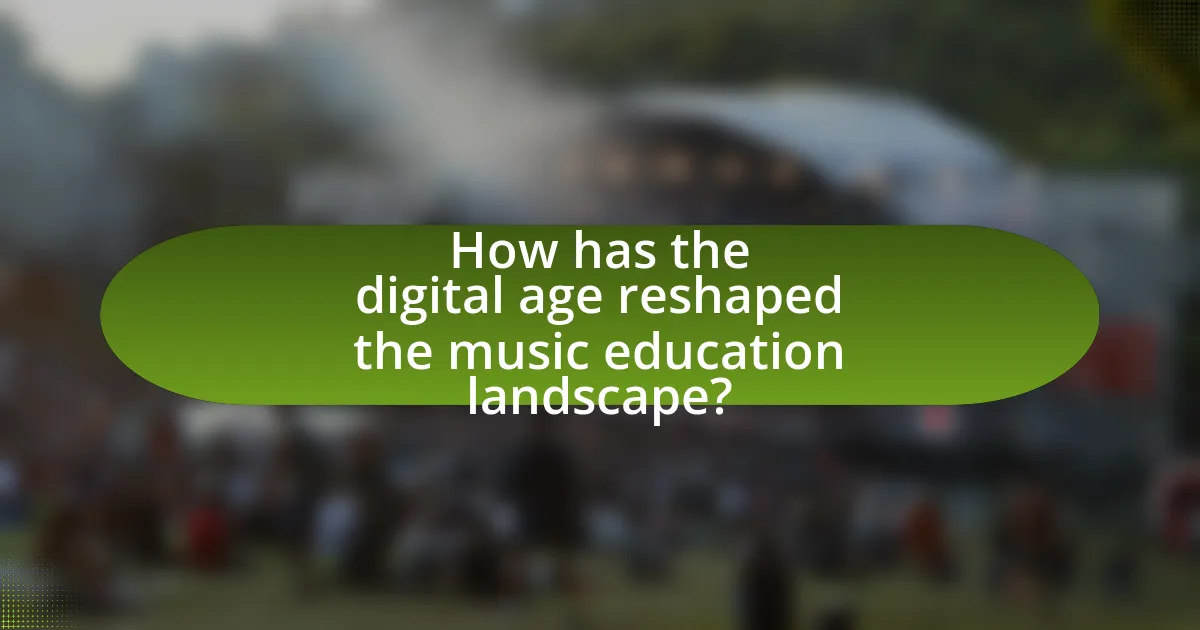
How has the digital age reshaped the music education landscape?
The digital age has significantly reshaped the music education landscape by enhancing accessibility and interactivity in learning. Online platforms and resources, such as YouTube tutorials and music education apps, allow students to learn at their own pace and access a vast array of instructional materials. According to a 2021 survey by the National Association for Music Education, 75% of music educators reported using digital tools to enhance their teaching methods, demonstrating a shift towards technology-integrated learning environments. This transformation has made music education more inclusive, enabling learners from diverse backgrounds to engage with music theory and practice through digital means.
What role does digital sheet music play in modern music education?
Digital sheet music plays a crucial role in modern music education by providing accessible, interactive, and versatile resources for students and educators. This format allows learners to easily access a vast library of music, often at a lower cost than traditional printed scores, facilitating a broader range of repertoire. Additionally, digital sheet music often includes features such as playback, transposition, and annotation tools, which enhance the learning experience by allowing students to engage with the material in a more dynamic way. Research indicates that the integration of digital tools in music education can improve student engagement and retention, as evidenced by a study published in the Journal of Music Education Research, which found that students using digital resources showed a 30% increase in practice time and a 25% improvement in performance skills compared to those using only printed materials.
How do educators utilize digital sheet music in teaching?
Educators utilize digital sheet music in teaching by providing interactive and accessible resources that enhance music learning. Digital sheet music allows for easy distribution and updates, enabling educators to share materials with students instantly and incorporate multimedia elements such as audio and video for better understanding. Research indicates that the use of digital tools in music education can improve student engagement and facilitate personalized learning experiences, as noted in the study “The Impact of Digital Technology on Music Education” by Smith and Johnson, published in the Journal of Music Education. This integration of technology supports diverse learning styles and fosters collaboration among students, making music education more effective and inclusive.
What resources are available for students to access digital sheet music?
Students can access digital sheet music through various online platforms and libraries. Notable resources include websites like MusicNotes, Sheet Music Plus, and IMSLP, which offer extensive catalogs of digital scores across multiple genres. Additionally, educational institutions often provide access to digital music libraries, such as the Berklee College of Music’s library, which includes a wide range of digital sheet music for students. These platforms typically allow for easy searching, downloading, and printing of sheet music, making them valuable tools for students in their musical studies.
How has the availability of digital sheet music affected learning methods?
The availability of digital sheet music has significantly transformed learning methods by providing instant access to a vast array of musical scores. This accessibility allows learners to quickly find and practice pieces that suit their skill level and interests, enhancing their engagement and motivation. Research indicates that digital platforms often include interactive features such as playback options, annotations, and the ability to adjust tempo, which cater to diverse learning styles and facilitate a more personalized learning experience. For instance, a study published in the Journal of Music Education Research found that students using digital sheet music demonstrated improved retention and performance skills compared to those relying solely on traditional printed scores.
What are the advantages of using digital sheet music for practice?
Digital sheet music offers several advantages for practice, including portability, accessibility, and interactive features. Musicians can easily carry a vast library of music on devices like tablets or smartphones, eliminating the need for bulky physical books. This portability allows for practice anywhere, whether at home or on the go. Additionally, digital sheet music often includes features such as adjustable tempo, playback options, and annotation tools, which enhance the learning experience. Studies have shown that interactive elements can improve retention and engagement, making practice sessions more effective.
How do digital platforms facilitate collaborative learning among musicians?
Digital platforms facilitate collaborative learning among musicians by providing tools for real-time communication, resource sharing, and collaborative creation. These platforms, such as Soundtrap and BandLab, enable musicians to connect regardless of geographical barriers, allowing them to share ideas, feedback, and musical compositions instantly. For instance, a study by the Berklee College of Music found that online collaboration tools significantly enhance creativity and learning outcomes among musicians by fostering a community of practice. This evidence supports the notion that digital platforms are essential for modern collaborative learning in music.
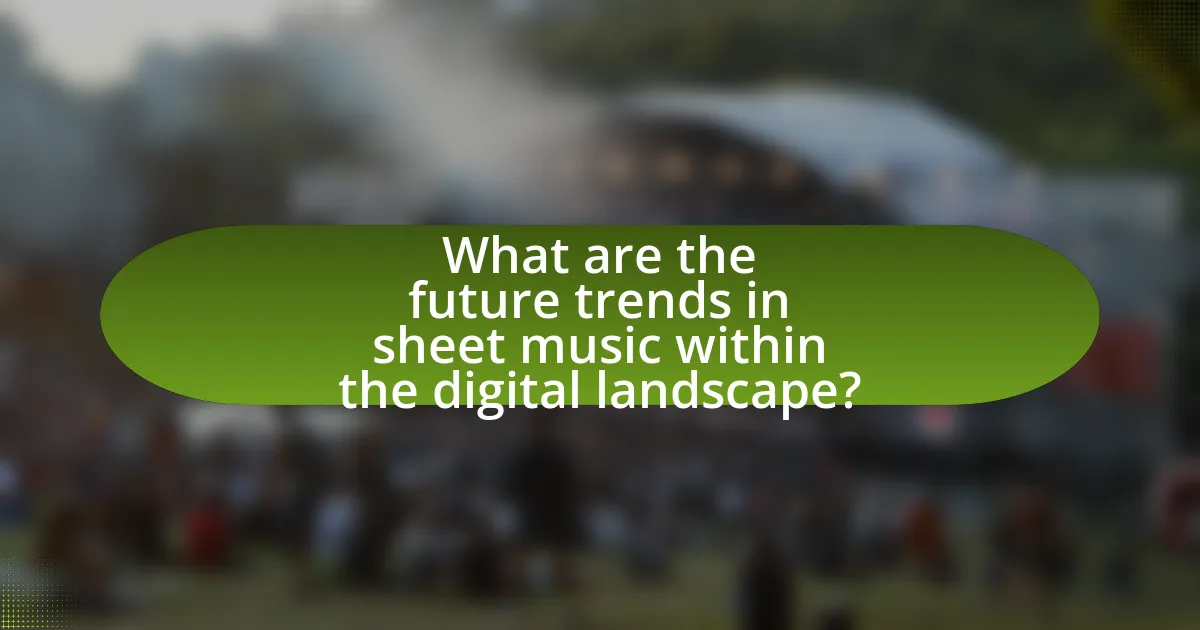
What are the future trends in sheet music within the digital landscape?
Future trends in sheet music within the digital landscape include increased interactivity, integration with artificial intelligence, and enhanced accessibility. Interactivity allows musicians to engage with sheet music through features like real-time notation changes and performance feedback, which are facilitated by software advancements. Integration with AI enables personalized learning experiences, where algorithms can suggest pieces based on a musician’s skill level and preferences. Enhanced accessibility is driven by cloud-based platforms that allow users to access a vast library of sheet music from anywhere, catering to diverse musical genres and styles. These trends reflect the ongoing evolution of sheet music as technology continues to reshape how musicians create, share, and learn music.
How might emerging technologies further influence sheet music?
Emerging technologies will significantly influence sheet music by enabling interactive and adaptive formats. For instance, advancements in augmented reality (AR) and virtual reality (VR) can transform traditional sheet music into immersive experiences, allowing musicians to visualize notes in three dimensions and receive real-time feedback on their performance. Additionally, artificial intelligence (AI) can analyze a musician’s playing style and suggest personalized arrangements or modifications to existing compositions, enhancing the learning process. The integration of cloud-based platforms facilitates instant access to a vast library of sheet music, enabling collaboration among musicians worldwide. These technologies not only streamline the creation and distribution of sheet music but also foster innovative ways for musicians to engage with their craft.
What potential innovations could change the way we create and consume sheet music?
Potential innovations that could change the way we create and consume sheet music include interactive digital scores, artificial intelligence-driven composition tools, and augmented reality applications. Interactive digital scores allow musicians to engage with the music dynamically, enabling features like real-time notation changes and integrated audio playback. AI-driven composition tools can assist composers by generating music based on user inputs, streamlining the creative process. Augmented reality applications can overlay digital sheet music onto physical instruments, enhancing learning and performance experiences. These innovations leverage technology to improve accessibility, creativity, and engagement in music creation and consumption.
How can artificial intelligence impact the composition of sheet music?
Artificial intelligence can significantly impact the composition of sheet music by enabling composers to generate new musical ideas and structures through algorithms and machine learning models. AI tools, such as OpenAI’s MuseNet and Google’s Magenta, analyze vast datasets of existing music to learn patterns, styles, and harmonies, allowing them to create original compositions that mimic various genres. This capability not only enhances creativity by providing inspiration but also streamlines the composition process, making it more accessible for both novice and experienced musicians. Studies have shown that AI-generated music can evoke emotional responses similar to human-composed pieces, demonstrating its potential to influence the future of music composition.
What challenges do composers face in the digital sheet music market?
Composers face significant challenges in the digital sheet music market, primarily related to copyright issues, market saturation, and revenue generation. Copyright concerns arise as composers must navigate complex licensing agreements to protect their work while ensuring accessibility for consumers. Market saturation complicates visibility, as numerous platforms and independent creators flood the market, making it difficult for individual composers to stand out. Additionally, revenue generation is a critical challenge; many composers struggle to monetize their digital sheet music effectively due to low pricing models and competition from free resources. These factors collectively hinder composers’ ability to thrive in the evolving digital landscape.
How do copyright issues affect the distribution of digital sheet music?
Copyright issues significantly restrict the distribution of digital sheet music by enforcing legal protections on musical compositions and arrangements. These legal protections prevent unauthorized reproduction, distribution, and public performance of copyrighted works, which can lead to legal repercussions for distributors who fail to comply. For instance, the U.S. Copyright Act grants creators exclusive rights to their works, meaning that digital sheet music cannot be shared or sold without permission from the copyright holder. This has resulted in a reliance on licensing agreements and digital rights management (DRM) technologies to ensure compliance, which can complicate access for consumers and limit the availability of certain works in digital formats.
What strategies can composers use to navigate the digital landscape?
Composers can navigate the digital landscape by leveraging online platforms for distribution, utilizing social media for audience engagement, and adopting digital tools for composition and collaboration. Online platforms like Spotify and Bandcamp allow composers to distribute their music directly to listeners, bypassing traditional gatekeepers. Social media channels such as Instagram and TikTok enable composers to showcase their work, connect with fans, and build a personal brand. Additionally, digital tools like notation software and collaborative platforms such as Soundtrap facilitate the composition process and enable real-time collaboration with other musicians, enhancing creativity and efficiency. These strategies are essential as the digital age continues to reshape how music is created, shared, and consumed.
What best practices should musicians follow when using digital sheet music?
Musicians should ensure proper organization and accessibility when using digital sheet music. This includes categorizing music files by genre, composer, or performance date, which facilitates quick retrieval during practice or performance. Additionally, utilizing software that allows for annotations and bookmarks enhances the usability of digital scores, enabling musicians to mark important sections or notes directly on the sheet music. Regularly backing up files to cloud storage or external drives is crucial to prevent data loss, as studies indicate that digital file corruption can occur unexpectedly. Furthermore, musicians should familiarize themselves with the features of their digital sheet music applications, as many offer tools for tempo adjustment, transposition, and playback, which can significantly aid in practice and performance preparation.
